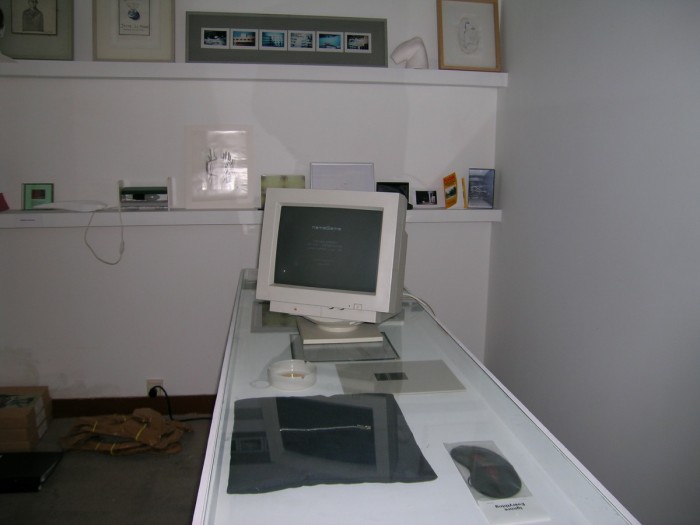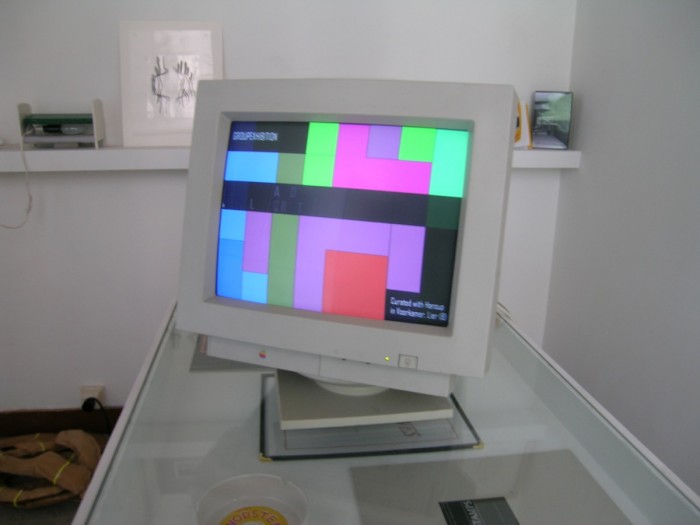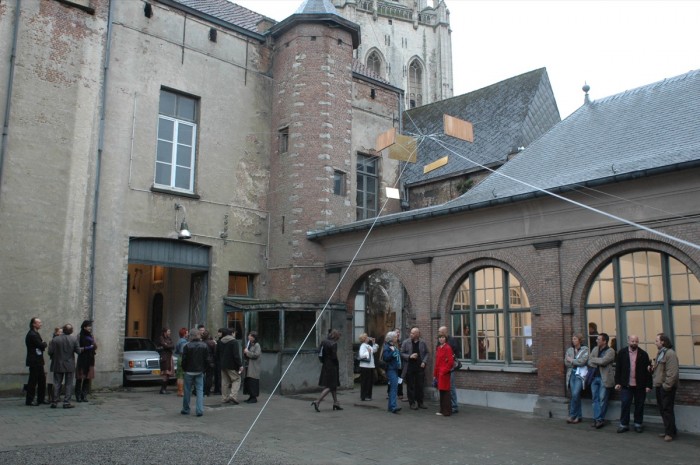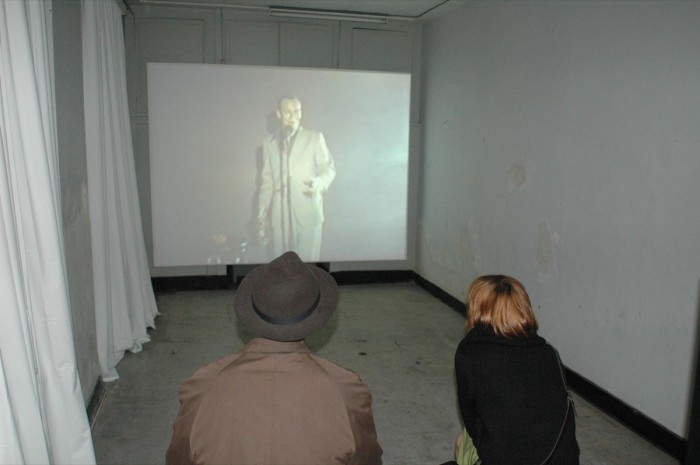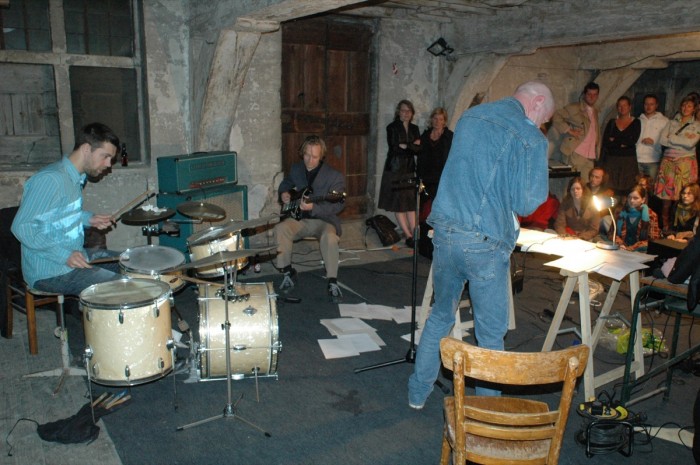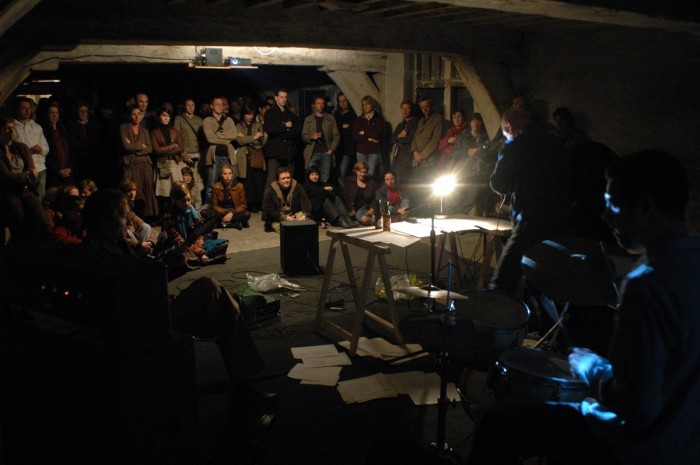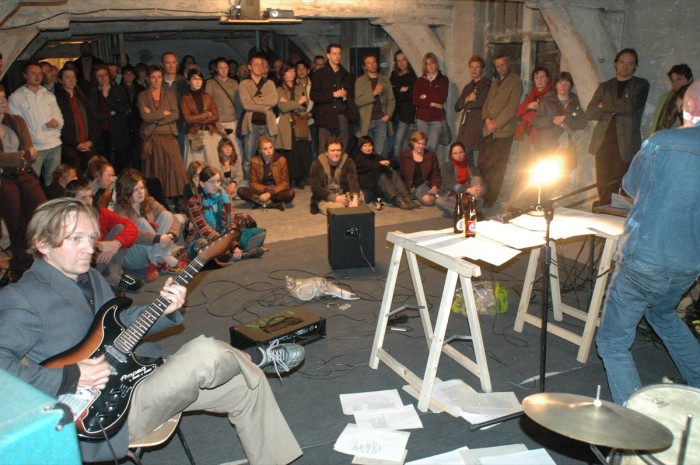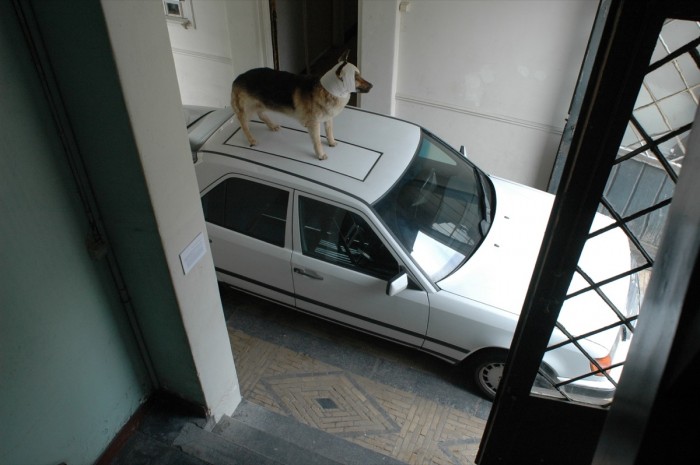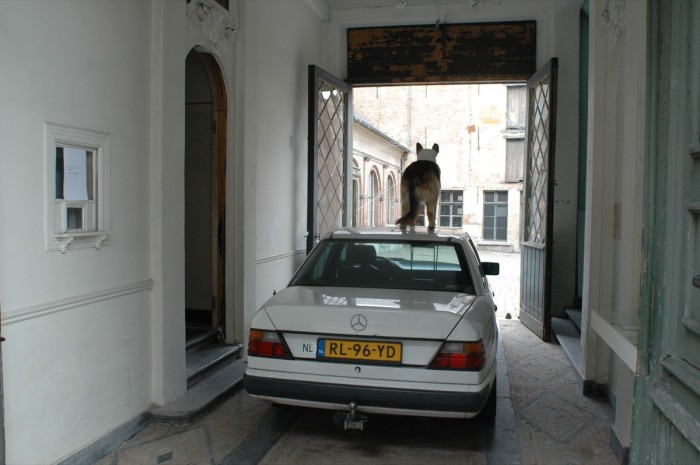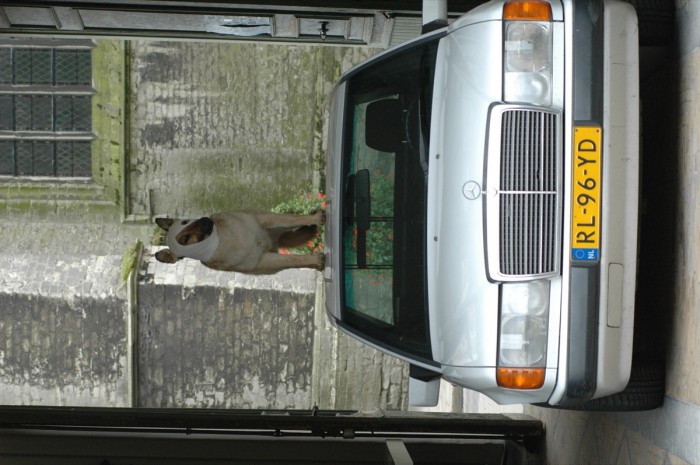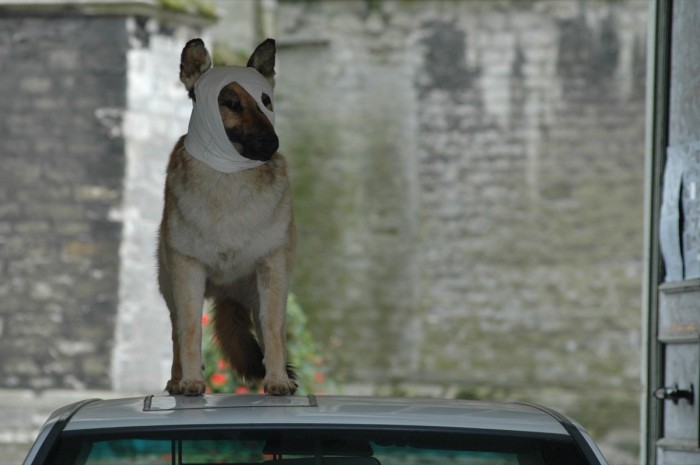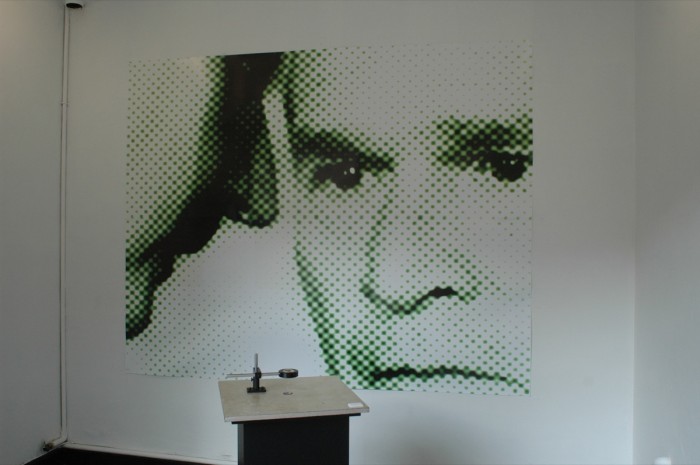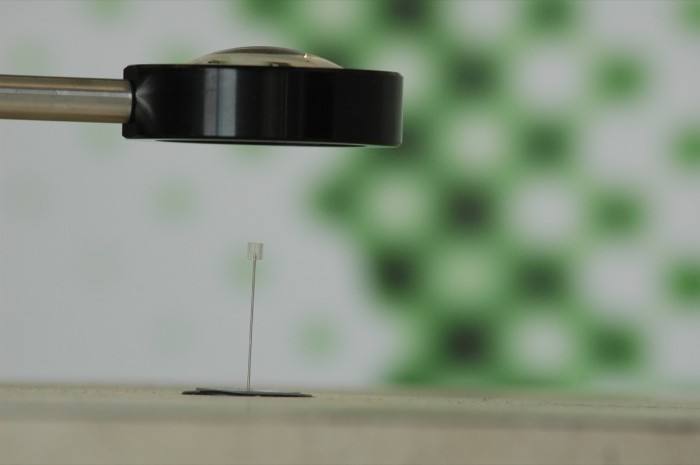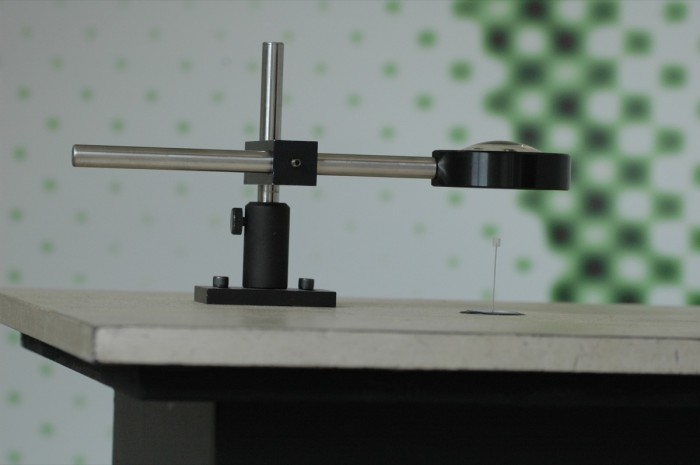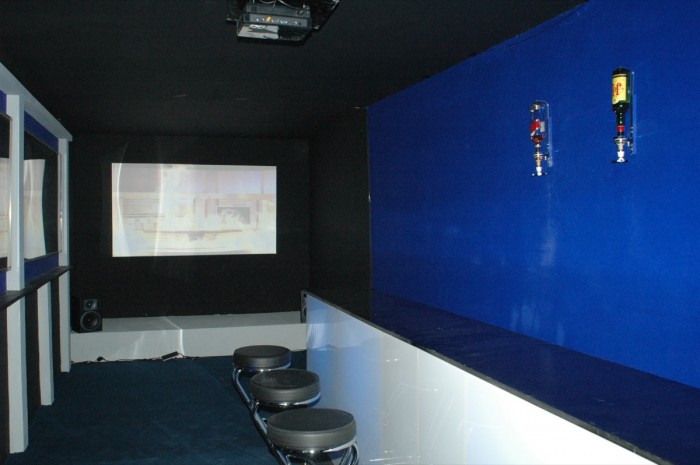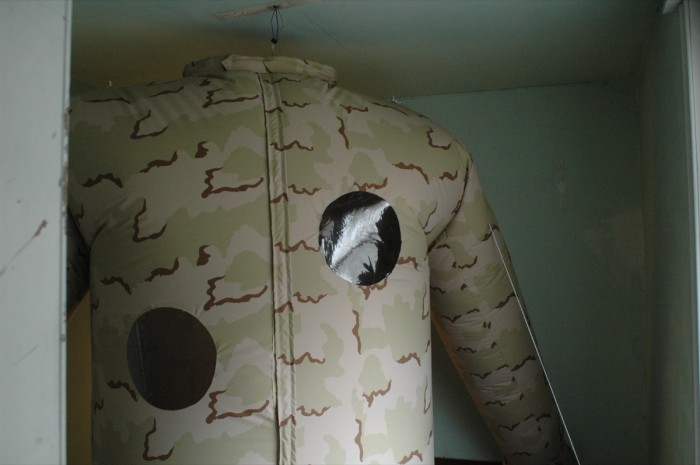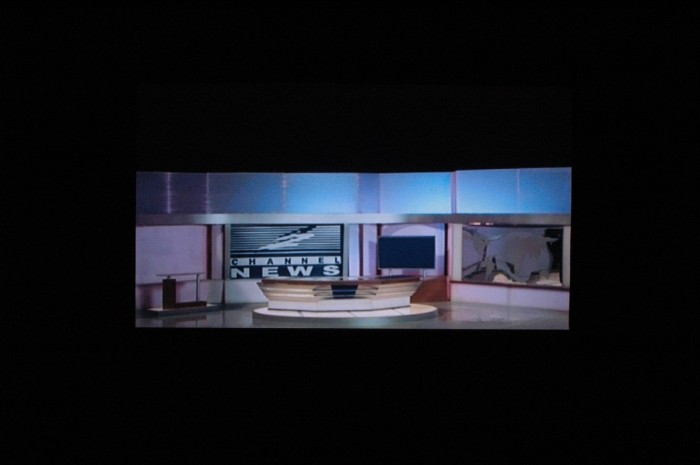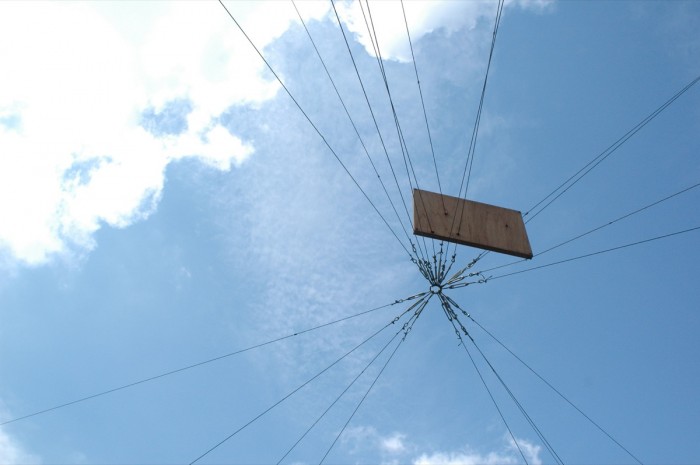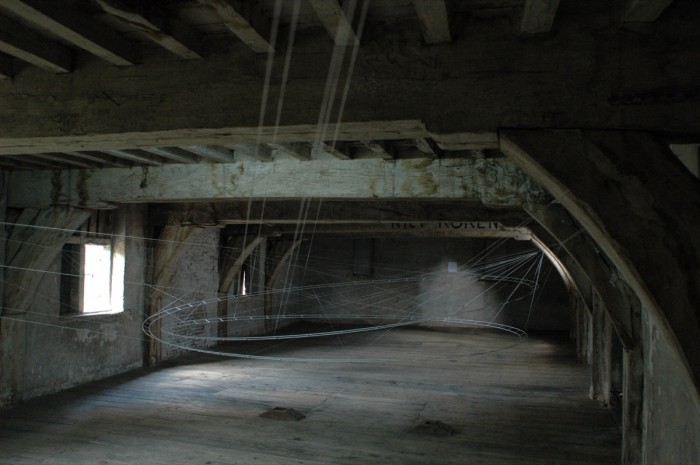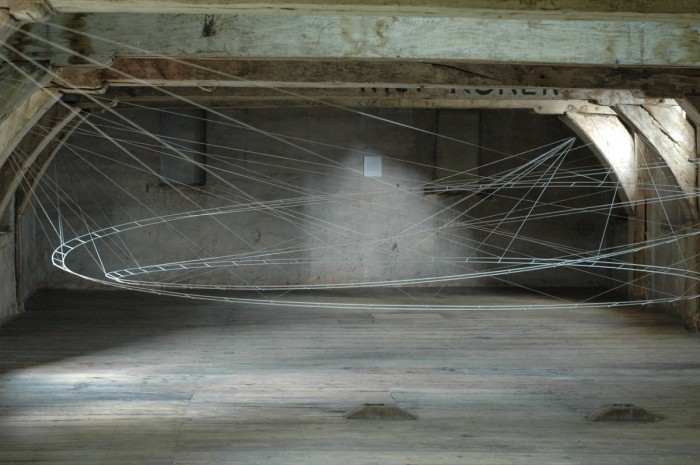MICHAEL BALLOU (USA)
KARIN BORGHOUTS
THOMAS BROADBENT (USA)
HARALD BUSCH (D)
WIM CUYVERS/MARC DE BLIECK
JOHAN DE WIT
HELMUT DICK (D)
FREDERIC GEURTS
HAN HOOGERBRUGGE (NL)
DAVID KRAMER (USA)
JAN ROBERT LEEGTE (NL)
GABRIEL LESTER (NL)
NORA LIGORANO/MARSHALL REESE (USA)
GUY RICHARDS SMITH (USA)
HERMAN VAN INGELGEM
HANS VERHAEGEN
ADRIAAN VERWÉE
KAREL WOUTERS
zaterdag 27 mei t/m 8 juli 2006
opening: zaterdag 27 mei 2006 vanaf 18 uur
PERFORMANCES:
ADACHI TOMOMI (J)
ERHARD HIRT/HARALD BUSCH (D)
THE SINGING PAINTERS
2
VOORKAMER is into its 10th year and introduces its second group exhibition on the premises of the H. Geest.
Twenty artists have been invited to produce new work or to participate with existing work in this historical venue.
You are kindly invited to the opening reception on Saturday 27th May as from 6 p.m. There will be performances and shows by Adachi Tomomi, Erhard Hirt/Harald Busch and The Singing Painters (Hans van Heirseele - vocals & lyrics, Michael Borremans - guitar, Merlyn Paridaen - drums & percussion, Jamez Dabramski Dean - industrial soundscape).

Michael Ballou (USA)
Michael Ballou is a force on the New York City art scene, largely by being a guiding spirit at Four Walls. This casual, artist-run art space was founded by Adam Simon and Michele Araujo in Hoboken in 1984, and has been in Mr. Ballou's large Williamsburg garage-studio since 1991. It's the kind of place where just showing up is what matters. It specializes in one-night events: art exhibitions open-call film screenings, readings, panel discussions, performance programs and occasional slumber parties.
Mr. Ballou usually acts as host, orchestrating and videotaping the proceedings and, when appropriate, showing his own short, low-tech, fuzzy-edged videos. (They're shot in Super 8, camera-edited and then taped while being projected on a wall, sometimes to live music.) Mike Ballou has a light but distinctive touch and a wonderful feeling for life's little moments of absurdity and beauty, both found and conjured. (Roberta Smith)

Karin Borghouts
Karin Borghouts takes pictures of places. She finds the largely architectural subject matters in public places; on the streets, in zoos and in amusement parks. She focuses on things you normally never even notice. Reality is minutely recorded. Due to their well-chosen background, rather than objective witnesses, her photographs feature an alienating character. The intriguing pictures are an accurate representation of a piece of world but at the same time, they endow the character of a disturbing dream. They rest on the edge between reality and fantasy. There are no people in the pictures. Yet it is about the way people think and do things and looking into the act of seeing. The photographs are taken with a technical camera and printed in large formats. The high quality is set to stimulate onlookers to watch ever so more carefully than if this was real life.
www.karinborghouts.be

Thomas Broadbent (USA)
In his work he uses a visual vocabulary that addresses many different social and political issues. He tries to approach these subjects in a multi-layered way, likes to involve the viewer in a sometimes physical way and believes in the idea of function following form in a work. He wants the viewer to become part of the art as a kind of added component. Art as entertainment, to be able to touch the work, as well as to interact with the work.
This artist often uses fabric as a means to make gender-related topics and the balance of power tangible and visible.

Harald Busch (D)
“My three-dimensional works are mainly installations that relate closely to a given space. These installations result from something like a dialogue with the room.
They are not about how much and what kind of space do I have to put my things in, but about discovering what is already there (in terms of space) and trying to find a way to work with that, to find a valid and accurate answer to a given spatial situation.”
www.haraldbusch.de

Wim Cuyvers/Marc De Blieck
http://users.pandora.be/b-site/bsites.htm

Johan de Wit
50X50cm

Helmut Dick (D)
Helmut Dick makes videos and installations in public places.
Dick processes everyday data into ambiguous situations with transversal poetry. The situations in his work are underlined with humor and absurdity; everyday things are taken out of their familiar settings so that new meaning strata may develop.
“The rising dog”
A German shepherd dog, standing beside the driver, is riding in a white Mercedes. Suddenly the dog rises through an opening in the car up to the top of the roof. After a little while the dog disappears back in the car. The work was made to join in ordinary traffic situations of everyday city life. It appeared in the streets of Amsterdam, The Hague (Netherlands), Bonn (Germany), Graz (Austria) Helsinki (Finland) and now for the first time in Belgium (Lier)
www.helmutdick.de

Frederic Geurts
“Panta rei” or “everything flows” according to Heraclites. You could say that “everything moves”. In physics, this is a fact; from the tiniest elementary particle to the biggest, the universe. The important element here is the force of gravity. Without it, the earth would not turn around the sun, and worse, the earth would not exist.
Force of gravity and eternal movement are two things that have always interested the artist and that most often if not constantly influence his work. On the one hand, there is this boyish fascination for the phenomena and on the other hand, he recognizes in them the human condition, death and desire.
Movement and force of gravity are also present in the building. Weight and resistance against it determine it for a large part. Movement seems to have stopped in it. Signs of an active past are still visible here and there, such as the large hoist wheel in the attic.
www.fredericgeurts.be

Han Hoogerbrugge (NL)
Studied painting at the Academy of Fine Arts in Rotterdam. In 1994, he swaps his paint brushes for a mouse. Attracted by the opportunities of the Web, he produces the site Modern Living, an experimental page at first in which he investigates into the possibilities of electronic publishing. In 1988, the site features a serious look with the start of an ongoing series of animated self-portraits under the title “Neurotica”. After several installments, the animations become interactive. In September 2001, number one hundred of the series is published, and also the last of the series. In 2002, he launches a new series: NAILS. Here also modern living is the starting point but in a more concentrated form. Beside publications of his own site, Hoogerbrugge also produced projects for other sites. The interactive music clip “Flow” in cooperation with the Japanese musician Gil Kay was featured on the site of the NPS, “Loss of facial features” on the site of the VPRO, “SPIN” on Sony’s site and more recently the interactive story “Hotel” on the site of Submarinchannel.
www.hoogerbrugge.com

David Kramer (USA)
Kramer’s art shows the inequality between the artist’s everyday reality and the exercise and glamour of success. The yearning for an idealized success is a constant criterion against which we measure our actual fulfillments. Throughout a variety of media, Kramer tries to catch the American Dream and in his videos, he mocks at his own obsessions. With a wry and perceptive sense of humor, the artist takes his life as subject matter while commenting on the everyday aesthetic of middle class American values
He is fully aware of the tragic, existential dilemma.
David Kramer will show new drawings and a new video-work “ODE TO THE ARTIST - Out of My Misery (scene1)”
www.feigencontemporary.com/artists/

Jan Robert Leegte (NL)
The work of Jan Robert Leegte has a strong focus on deconstructing the architectural and sculptural experience. Leegte tries to understand and expand the physical experience.
A central tool in the work is the computer. As the computer interface has create an interactive space used by billions daily, the concept of physicality is slowly being expanded. By introducing the screen material back in the spatial context, Leegte tries to have the viewer question the perception of material and space.
Jan Robert started exploring the sculptural properties of internet browsers and software in general in 1997, using buttons, scrollbars, and table borders in online installations; in earlier sculptural works he used unusual materials, for instance creating walls from sheets of Xerox copy paper or large slabs of brown packing paper. The various elements of the browser window appear to have a striking physical reality, gained through user familiarity, interactivity and animation. Most people consider the scrollbar to be a virtual object, not weighted with any real-world significance, but in use it triggers reactions such as frustration, anger, and boredom-induced clicking. Reactions like these suggest a subconscious acceptance of the inherent “reality” of these objects.
www.leegte.org

Gabriel Lester (NL)
www.gabriellester.com/enter.html

Nora Ligorano/Marshall Reese (USA)
In Memory of Truth takes off from the debate attributed to the medieval theologian Thomas Aquinas regarding the passage of angels. Over time the philosopher's original proposition has been rephrased to be about angels dancing on a pin.
Ligorano/Reese reinterpret his theory with this installation. Like many of the artists' other pieces, In Memory of Truth combines media and manipulates imagery from print, film, and internet sources to reveal latent political meanings and messages.
Using a custom-designed optical system incorporating a micro-LCD display and primary lens, the artists have devised a way to project moving video images on the head of a pin. The viewer sees a montage of Hollywood films with the aid of a magnifying glass as a commentary on the portrayal of war and patriotism and the growing militarization and political orientation of America.
“Warsaw, Beirut, Belfast... the streets themselves have now become a permanent film-set... The West... has now plunged into the transpolitcal pan-cinema of the nuclear age, into an entirely cinematic vision of the world... Those American TV channels which broadcast news footage around the clock... have understood this point very well. Because in fact this isn't really news footage any longer, but the raw material of vision...” (Paul Virilio)
www.pureproductsusa.com

Guy Richards Smith (USA)
www.roeblinghall.com/artists/smit/default.htm

Herman Van Ingelgem
“Local White - 2005”
The work of Herman Van Ingelgem can be read as a mutation of existing architecture. His interventions are momentarily grafted on any available spatial element and structure. They seek out the folds, the spaces, and by means of unfolding or duplicating, try to enhance the conditions and meanings thereof. His installations also seek to engage in a dialogue with the work of the other participating artists.
www.transit.be

Hans Verhaegen
“Group exhibition”
Typical of a group exhibition is the list of names of the chosen few. Surnames, names and nationalities. For those who know about these things, automatic bells are going to ring and all sorts of networking, relationships and interests will become obvious. Outsiders might just as well open a phone directory.
Under the form of an invitation, “Group exhibition” mixes all the surnames and names on purpose. You get a number of artists, who are unknown even to the insiders, or better still, artists who never were. “Group exhibition” therefore becomes an exhibition within an exhibition. And when you look at the names for a while, it sets your mind boggling.
“Group exhibition” is a name game against a background of king-size pixels, a zoom into a jumble of people all tangled up with each other. Those who don’t have a clue who those names belong to, will no doubt be hypnotized by the endless colour combinations.
“Group exhibition” is a digital work in situ.
www.hansup.be

Adriaan Verwée
“It was in the news today”
In a narrow café, the slow-motion shooting of a disintegrating news studio is being projected on a screen. Is this lapse of time on screen slow or has time slowly come to a halt on the long counter? A stretched-out look around brings the scenery, the news studio and the café together in one material presence: both are made of laminate, mirrors, Plexiglas and plastics.
If reality is a construction, then this construction is scenery for Adriaan Verwée. After the installation “The Final Speech” that presents history as a steadily moving, unreal film set; “It was in the news today” focuses on the theatrical aspect of news shows. The critical dimensions of the installations are diverted since the architectonic interventions are complete: setting up a surrounding in which you enjoy being.

Karel Wouters
“When I’m making these works, I never start from a well-defined concept. There is always a picture there without any particular meaning. Things that I haphazardly come across, that seem irrelevant at first sight, that become certainties. Before placing them in a new context or repeating them, they no longer escape our attention; they acquire more weight and contribute to an image that follows its own irrational logic. On the one hand, I have this desire, by sorting out these things, to create an image that looks pleasant and familiar. On the other hand, you could consider these useless constellations as a means to fill in an impression of void, boredom, loss and loneliness.”

+ performance Adachi Tomomi (J)
Adach Tomomi, born in Japan in 1972, is a performer/composer. He presents his own works combine voice improvisation and real time sound processing with self-made sensor system like infrared sensor shirt. Also he performs some of strange self-made instruments named Tomomin, Tomoring and so on.
Recently he is working also in the field of sound poetry, video art and installation. He has released CD’s: solo “sparkling materialism” (naya records), Adachi Tomomi Royal Chorus “nu” (naya records) and Adachi Tomomi Royal Chorus “yo” (Tzadik).
www.adachitomomi.com

+ the romberg pieces by Erhard Hirt and Harald Busch (D)
Romberg 1/Romberg 2
Two pieces for video projection and live music, about ten minutes each, by Harald Busch (video + editing) and Erhard Hirt (guitar + signal processing).
Whereas image and sound develop in parallel ways in Romberg 1, Romberg 2 is based on a few short outtakes from diverse feature films.
These small image+sound units have been edited to form the skeleton of a piece that comes to life when it is generated live...
www.erhardhirt.de
www.haraldbusch.de

+ concert “the singing painters”
The Singing Painters. Radical jazz punk trio from Ghent. The impact of a bomb attack. Musical guerilla. The explosive character of The Singing Painters has a subversive undertone, the lyrics are alternately violent, provocative and intimate, and the tone setting is a mix of jazz, blues and punk.
Never rehearse. Throw themselves every time without preparation at the audience. No common denominator. Aficionados talk of a mix of Captain Beefheart and The Doors. The Singing Painters is exactly what it says: 3 painters doing music.
Vocals & lyrics: Hans van Heirseele, Lead guitar: Michael Borremans, Drums & percussion: Merlyn Paridaen + industrial soundscape: Jamez Dabramski Dean
The present set calls itself “Normal American Weather For This Time Of The Year”.
Discography: “Embryo Dictaphone” (1999), “Fool Control” (2003)

